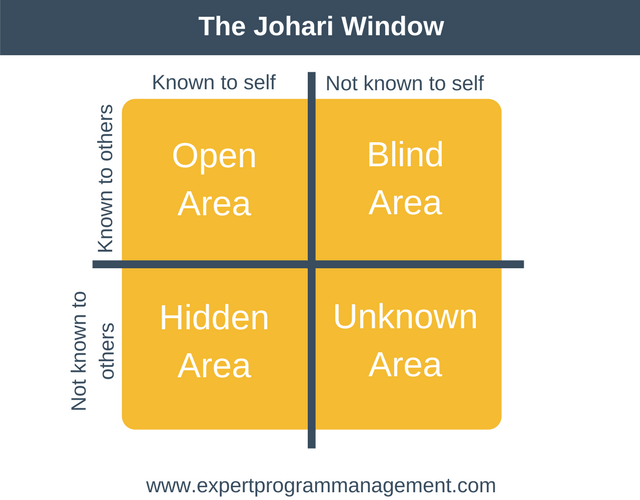If assigned a group project in a class, most students will inevitably be displeased and provide negative feedback and resistance to the suggestion. The Johari Window model can help people to learn more about themselves, and the situations they face in life.
Complaining of imbalanced work ethics and uneven contribution efforts, most people are not thrilled with the prospect of group work that has a grade, ranking or other high-pressure outcome attached to it. Group politics and personality conflicts are invariably major concerns.
However, most individuals will find themselves, at some point in their careers, working within the confines of a group dynamic.
Whether it is a medical or legal practice, an advertising agency or a University, working in a group environment is almost unavoidable. Regardless of the size of the business, there will be co-workers and supervisors.
Therefore, the question then becomes how to address those very real concerns of the group projects? How to soothe or even to avoid the potential for personality clashes or misunderstandings?
Some companies will introduce retreats wherein all employees must go to perform activities designed to build team work or to take the Myers Briggs tests to understand your colleagues.
However, there is another option, one that focuses on self-awareness and personal development. It is known as the Johari Window model.
What is the Johari Window Model?
Developed in 1955 by psychologists Joseph Lutz and Harry Ingham, the Johari Window is a technique for better understanding of the self within a group dynamic.
The Johari Window can be used to improve communication between group members and to enhance the individual’s perception on others. Although the name sounds very exotic, it is merely a combination of the two men’s first names.
Based on the concept that trust can be gained by revealing information about yourself to others, you then will learn more about yourself from other people’s perceptions of you. As the name suggests, the structure of the technique is a window with four panes, arranged in a two by two grid.
Each individual participating in this exercise is represented by an entire window, and the four quadrants represent personal emotions and facts that may be known or unknown by the particular individual and others.
How does someone complete this activity?
A person is given a list of adjectives from which to choose the ones that describe his or her personality. The same list is then provided to group members who also choose the adjectives to describe that person.
The adjectives are then inserted into particular panes of the window. This technique is a “test” that one can take to better understand his or her own personality and how he or she relates to others.
The 4 Johari Window Panes
The panes of the window have significant meaning and therefore, they will be discussed individually below.
1. Open
Also termed the “self-area, self-arena, free self and free arena”, this panel contains well-known information about the person, including behavior, attitude, skills, views and feelings, information that is known to both the person and to others.
Adjectives chosen by both the individual and the peers are put into this quadrant, as it suggests that these are the traits that are perceived by everyone.
The truthfulness of these adjectives is of course based on what the subject has chosen to reveal to the others or to the image that might have been carefully constructed. It can also be the result of personal interactions.
For example, if the subject and a particular co-worker do not like each other, this might be reflected in the choice of group adjectives. If the subject is popular within the group, the same outcome is also possible. Therefore, it is important to remember that the “open” quadrant is based on perception, just as much as it may be based on facts.
In the realm of communication, this first quadrant is where dialogue is a two-way process, indicating the socializing with, and feedback from, the group members.
Ideally the relationship will be effective and dynamic, signifying “feedback solicitation” in which listening and understanding is appreciated and emphasized.
The size of the quadrants is not fixed, but can be altered based on various factors, including the revelation of certain information to others. In this manner, the person learns to trust the other members of the group and ultimately communication and understanding is enhanced.
2. Blind Self or Blind Spot
As the name implies, this quadrant is how peers perceive the subject but the subject does not know it.
The person may even have a completely different concept of themselves at odds with the peer perception. This image may entail things the subject does not know about himself or herself, such as subtle behavioral cues or mannerisms.
Others may interpret a facial expression, a tone of voice or quiet mood differently than expected and in surprising ways.
The adjectives selected by the other group members are entered into this window pane. None of the adjectives chose by the subject are included.
For group communication to be optimized, this “Blind” quadrant must be reduced, ideally so the Open quadrant can be increased, and the ebb and flow of the group dynamic becomes easier.
3. Hidden or Façade of Avoided Area
This panel represents information known only to the subject, but kept, or “hidden”, from their peers.
Personal information such as secrets, past experiences, past traumas, personal opinions, political views, religious thoughts, embarrassments, and vulnerabilities are items that may be withheld from sharing in a group environment.

Also, people who are very shy or introverted may keep to themselves more than extroverted individuals.
Previous bad experience with toxic group or work environments may contribute to a decreased level of trust as well, and the subject may not feel safe revealing opinions and perceptions.
The argument is posited that hidden information negatively impacts the group dynamic and hinders communication. In order to release this obstacle, the hidden information should be revealed. However, this may be easier said than done, and therefore, this area might need time and space for improvement.
Adjectives selected only by the subject are placed in this cell, as the choice is based on inside information.
4. Unknown or Unknown Self
The great unknown is represented by this cell, since it contains information unaware to both the subject and the group.
It may represent repressed emotions due to traumatic events. However, it may also be skills and abilities that have yet to emerge due to external circumstances.
Hidden talents and qualities remain unknown until they are needed or a situation occurs that calls for certain ideas and actions. Someone may not know they possess leadership capability until he or she steps up to the call.
It also has been suggested that the subject’s behavior or motives are unknown to everyone because they are not relevant to the situation or because people are willfully ignorant of them.
Because they are unknown, adjectives that neither the subject nor the group have chosen go in this last area. In an attempt to decrease the unknown, open communication is encouraged, thus expanding the “open” arena where communication becomes an effective dialogue between subject and group.
Expansion of the Open panel by reducing the unknown and the blind quadrants is meant to result in great knowledge of one’s self and increased self-awareness.
Decrease of the hidden quadrant by the subject volunteering information about himself or herself improves interpersonal relationships, friendships, and the overall group dynamic.
In this way, the Johari Window method may be used for personal therapeutic reasons. It also can be used for family therapy, marriage therapy, and group work, usually associated with business or corporations.
It is a means by which disparate people brought together for work, or perhaps social, purposes create an acceptable way of communicating, thus eliminating the potential for conflict and creating a smooth operation.
If done for an individual solely, it can improve communication skills, help to resolve trust issues, increase self-awareness, particularly how others may perceive you, and perhaps offer glimpses into the motivation behind specific behavior.
Increasing your self-awareness is important for personal growth. If you want to know more about your unknown self, take a few minutes to watch this video and learn about proven strategies to help your efforts:
The Johari Window: A Great Tool for Self-Discovery
Another interpretation of the Johari Window model is to identify each panel as a “persona”, so that the subject might get a deeper understanding of the self.
With this approach, the Open Panel becomes the Public Self.
Usually considered the most together and relaxed of the personas, the Public Self is comfortable with who he or she is and they are not easily embarrassed.
Well-adjusted, they do not really care what others think of them. However, this can mean that they are oblivious to others and their actions.

The Blind Spot is the Naïve Persona, indicating that their lack of self-awareness is glaring. They make social mistakes and do not realize it, not do they understand how others see them. Due to this very obliviousness, they may be destructive and feared, and lack emotional intelligence.
The Hidden Self can be deemed the Private Self or the Secret Persona. Mysterious and quiet, they talk little about themselves and do not easily volunteer information. They appear to be distant, secretive and stuck-up when in reality, they might be shy and introspective.
Preferring to retreat from the world rather than engage with it, the Secret Person may the result of childhood or personal traumas.
Finally, the Unknown quadrant may be relabeled the Mysterious Persona because they act oddly, and strangely, but do not appear to notice it. They are not necessarily introverted but can be solitary, not needing or desiring the company of others.
There is also the possibility that they might not be interested in seeking any self-awareness and do not seem to care to know about themselves, their motivations, their behavior, and their intelligence.
Different Ways to Use the Johari Window Model
By reimagining the Johari Window Test as a persona test, it can reveal a great deal of information about someone, to help them on this road of self-discovery.
The concept of shifting the boundaries and sizes of the quadrants remains and one can grow, change, and shift themselves and their actions based on the results of the test.
We spend a lot of time defining ourselves, but we probably don't use a formal method to learn where those boundaries are. Some may be useful, but others could be limiting our health and happiness.
Following please find the links to taking the Johari Window Test online:
Final Thoughts on the Johari Window
The Johari Window technique seeks to help the test taker on a personal and professional level. The subject can get to know a great deal about themselves through their own thoughts and others’ perceptions, both of which have their place is self-awareness.
The technique develops communication and social skills which are needed on a daily basis, regardless of the specific workplace. If you would like to gain a glimpse into who you are, then dare to look into this window and enjoy the view.
We have so many tools for self-exploration, and the Johari Window model could be a great one for your personal growth. It can be used on its own, or with other techniques that will help you unlock your potential, and live a better life!
And if you're looking for more ways to learn about yourself, check out these blog posts:
- 7 Fun Printable Personality Tests for Students
- 5 Imposter Syndrome Types: Which Are You?
- 11 Best Love Compatibility Tests for Couples
Finally, one proven way to improve your happiness and life satisfaction is to focus on goals that truly matter. To get started, check out this FREE printable worksheet and a step-by-step process that will help you set effective SMART goals.

Nicholas Say was born in Ann Arbor, Michigan, and has been interested in global belief systems from a young age. This area of study led him to research many Eastern philosophical systems, including Vedic and Buddhist ideas and practices. Today he thinks that humanity needs to find ways to be happy with being, as opposed to possessing and doing. His views fall roughly in-line with the late philosopher Alan Watts, who he venerates as great teacher.



